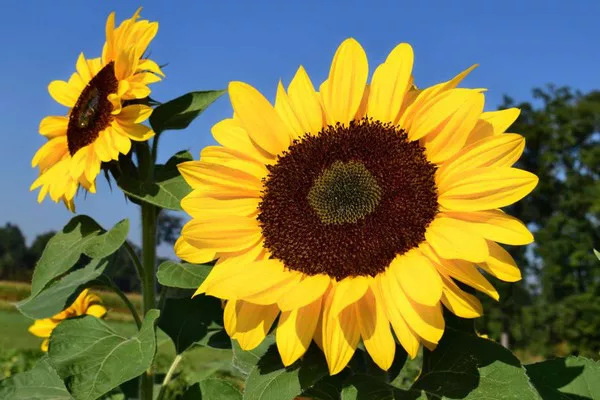Sunflowers (Helianthus annuus) have long captivated us with their vibrant blooms, towering stalks, and delightful golden faces that seem to follow the sun. These cheerful flowers are not only a symbol of warmth and happiness but also come in a remarkable array of varieties, each with its own unique characteristics and adaptations.
The Family of Sunflowers
To understand the multitude of sunflower varieties, it’s important to first grasp their botanical taxonomy. Sunflowers belong to the Asteraceae family, which is also known as the daisy family. This family includes a wide range of flowering plants, such as asters, daisies, and dandelions. Sunflowers are further classified into the genus Helianthus, and Helianthus annuus represents the most well-known species. However, there are several other notable species, hybrids, and cultivars, each with its own distinctive traits.
Common Sunflower (Helianthus annuus)
The common sunflower, Helianthus annuus, serves as the foundation for countless sunflower varieties. This native North American species boasts the classic sunflower appearance, with a large central disk surrounded by brilliant yellow petals. Common sunflowers are prized not only for their ornamental value but also for their many practical uses, including oil extraction, birdseed production, and as a source of food for both humans and wildlife.
Ornamental Sunflowers
Ornamental sunflowers are perhaps the most familiar and beloved variety. These sunflowers have been bred and cultivated for their striking appearance, which ranges from deep burgundy to pale yellow. Some of the most popular ornamental sunflowers include the ‘Mammoth Russian,’ ‘Autumn Beauty,’ and ‘Ring of Fire.’ These varieties are often grown for cut flowers, bouquets, and decorative landscaping.
Giant Sunflowers
Giant sunflowers are notable for their towering stature. The ‘Russian Giant’ holds the record for the tallest sunflower, reaching heights of over 25 feet. These sunflowers are not only impressive but also serve as a source of seeds for birdfeed and sunflower oil. Their large heads can contain numerous seeds, making them valuable for commercial use.
Dwarf Sunflowers
On the opposite end of the size spectrum, dwarf sunflowers are compact and petite, making them ideal for smaller gardens, containers, and indoor spaces. Varieties like the ‘Elf’ and ‘Little Becka’ are perfect choices for those with limited gardening space. Dwarf sunflowers maintain the same vibrant blooms and striking yellow petals as their larger counterparts, just in a more space-efficient package.
Double-Flowered Sunflowers
Double-flowered sunflowers, as the name suggests, have a higher number of petals than the typical sunflower. This creates a lush and full appearance that is often likened to a sunflower in full bloom. Varieties like ‘Double Dandy’ and ‘Teddy Bear’ are admired for their unique and luxurious appearance. Double-flowered sunflowers have become a favorite among florists and garden enthusiasts.
Colored Sunflowers
While the classic sunflower is recognized for its radiant yellow petals, there are colored sunflowers that break from tradition. Varieties like ‘Red Sun,’ ‘Chianti,’ and ‘Strawberry Blonde’ introduce shades of red, burgundy, and even bicolor blooms to the sunflower family. These colorful options add a refreshing twist to the classic sunflower look.
Teddy Bear Sunflowers (Fuzzy Sunflowers)
Teddy bear sunflowers, often referred to as fuzzy sunflowers, feature an interesting twist – their foliage is covered in fine hairs, giving them a soft, furry appearance. This unique texture sets them apart from the smooth leaves of traditional sunflowers. Teddy bear sunflowers are a charming addition to any garden, providing both visual and tactile appeal.
Dwarf Sunflowers with Dark Centers
Another distinctive variety is the dwarf sunflower with dark centers, which presents an intriguing contrast. These sunflowers feature dark, almost black, centers surrounded by bright yellow petals. The ‘Black Magic’ sunflower is one well-known example. This striking combination adds an element of drama and sophistication to the typical sunflower look.
Multi-Headed Sunflowers
Multi-headed sunflowers, also known as branching sunflowers, produce more than one flower head on a single stem. This trait increases the overall yield of blooms, making them a great choice for gardeners who seek an abundance of sunflowers. Varieties like ‘Sunflower Music Box’ and ‘Sunflower Lemon Eclair’ are known for their prolific flowering.
Seedless Sunflowers
Seedless sunflowers, such as the ‘Golden Cheer,’ have gained popularity for their unique characteristic of producing little to no seeds. While this may seem counterintuitive for a sunflower, it’s a valuable trait for those who want to enjoy the beauty of sunflowers without dealing with the mess of seeds. Seedless sunflowers are often used in bouquets and floral arrangements.
Conclusion
The incredible diversity of sunflowers is a testament to the wonders of nature and human ingenuity. From the towering giants to the delicate dwarfs, and from the classic golden sunflower to the vibrant reds and burgundies, the varieties of sunflowers are a testament to the versatility of this iconic flower. Whether you grow sunflowers for their aesthetic appeal, practical uses, or cultural significance, there is undoubtedly a sunflower variety to suit your needs. The world of sunflowers is a rich and colorful one, offering endless opportunities for gardeners and enthusiasts to explore and appreciate these sunny blooms. So, if you ever find yourself pondering how many varieties of sunflowers there are, remember, the answer is as vast and diverse as the sunflower fields themselves.


